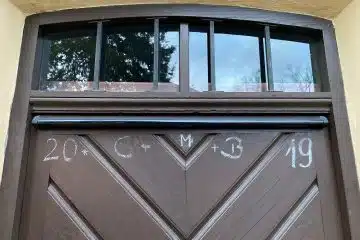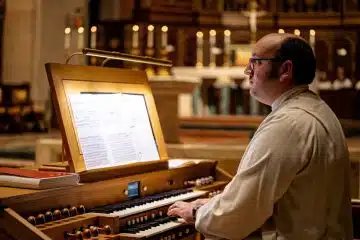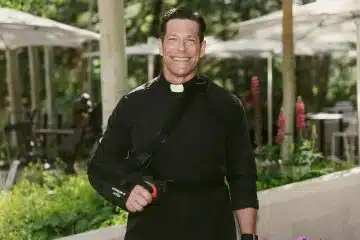A cardinal, an archbishop, and a bishop reveal their vocation stories
CNA Staff, Dec 17, 2023 / 09:00 am
Serving at the altar for Venerable Fulton J. Sheen played a major role in one U.S. cardinal’s vocational journey. For another bishop, falling to his knees at the tomb of St. Peter was a pivotal moment. And an archbishop said the “beauty and majesty” of the Church’s liturgy aided him along his spiritual journey.
This past November at the U.S. bishops’ conference in Baltimore, three U.S. prelates serving different dioceses across the country shared their vocation stories with CNA. Each of them said yes to God and never looked back.
‘Something adventurous’
San Francisco Archbishop Salvatore Cordileone, 67, told CNA: “I always knew I wanted to do something worthwhile with my life, something to make the world a better place, something adventurous and unconventional.”
Cordileone’s father, Leon, a Navy veteran, was a commercial fisherman in San Diego, and the future archbishop would spend a lot of time around his dad’s boat.
He said that there were a lot of former Navy men working there and that “kind of got in my imagination.”
“So I thought ‘maybe I’ll serve my country,’” he said, considering the Navy or some other military branch.
But a shift took place toward the end of his high school years and during his first year of college at San Diego State University when he was “getting more spiritually serious.”
“I always took my faith seriously. I always practiced it. I never stopped going to church. Even as a teenager, I’d go on my own. But then I was starting to get more spiritually serious, thinking about the big questions of life: ‘What’s it all worth? What does God want me to do?’” he said.
There was a young priest at his parish whom Cordieone called an “inspiration,” adding that “his preaching really connected well with things I was dealing with, trying to think through my life.”
“So I finally found the courage to talk to him about it,” he said.
The priest sent Cordileone on a discernment retreat at a local seminary, and “it wouldn’t get out of my mind, so I knew I had to enter the seminary, at least give it a try.”
Cordileone said that he wasn’t convinced of his vocation when he entered the seminary initially, adding that “it took a few years.”
“And I wasn’t at peace until I accepted it,” he said, adding that it brought him “a sense of freedom.”
That feeling of freedom was a confirmation to Cordileone that God was calling him to be a priest, he said.
The archbishop said that there were signs of a vocation “all along” in his life.
“It’s the sort of thing, when you look back in retrospect, you can see where God is leading you and he’s been working that way in my life,” he said.
Cordileone said that as a boy and young man, the Eucharist and the Mass were “instrumental” for him.
“When I was a boy, I eventually realized I was different because I liked dressing up and going to church,” he said with a chuckle.
The archbishop said that it was the “beauty and majesty” of the Church’s liturgy and frequenting the sacrament of reconciliation that was instilled in him early in life that aided him in his spiritual journey.
Cordileone was ordained a priest on July 9, 1982. He was ordained to be the auxiliary bishop of the Diocese of San Diego on Aug. 21, 2002, appointed bishop of Oakland in 2009, and then appointed archbishop of San Francisco three years later.
Serving for Sheen
For archbishop of Boston Cardinal Sean O’Malley, a vocation to the priesthood grew out of two blessings: his “faith-filled family” and a parish of “wonderful priests.”
O’Malley, 79, said that he, his parents, and his siblings were deeply involved in the life of St. Luke the Evangelist Parish in Lakewood, Ohio, adding that he became an altar server at just 6 years old.
“I grew up with the old Mass where priests weren’t allowed to celebrate without servers, and since we lived only two doors away from the church, the parish priest recruited us. So I would go with my older brother and serve, and he taught me those Latin prayers when I was 6 years old,” he said.
O’Malley described the parish life as “vibrant,” adding that “the Eucharist was the centerpiece of it.”
Growing up, O’Malley’s uncle was a priest and baptized him. That, in addition to the “wonderful priests in the parish who were very close to the families and the children,” made quite an impression on the future cardinal.
One of those clergymen who played a role in fostering a vocation in the young O’Malley was none other than Venerable Fulton J. Sheen, who used to visit the parish for one week each year because of his “very close” friendship with the pastor, O’Malley said.
O’Malley said during Sheen’s visits to the church, he would preach a homily every day, a practice that the cardinal said was uncommon at the time and was only typically done on Sundays.
He described the church as having “standing room only” when Sheen preached.
“I’m amazed how he was able to preach in such a way that would connect with everyone. I mean, we were children, but we would sit there and we probably didn’t understand half of what he was saying, but he had an energy and an electricity about him. He would just connect with you. It was really amazing,” he said.
O’Malley also noted that he would see Sheen pray a Holy Hour in front of the Blessed Sacrament in the sacristy before Mass.
He even remembers the pastor telling him: “The bishop is doing his Holy Hour; don’t bother him.”
He said that he was “so impressed” by Sheen’s Holy Hour.
“His writings to priests and seminarians would always stress how important that was in his spirituality. And the Holy Hour has always been very important for me, too, as the time before the Blessed Sacrament to watch and pray,” he said.
O’Malley, a Capuchin friar, said that one day, his older brother was going on a retreat at a Capuchin monastery and he came along for the ride with their father.
O’Malley met an old German friar who was working in a garden there and spoke to him for a long time before heading home.
“When we were going home, my dad said, ‘That old friar is the happiest man in the world,’” he said.
At first, O’Malley thought, “He didn’t have a beautiful wife, he didn’t have a nice car, didn’t have nice threads. What a boring job, hoeing that garden.”
“But instinctively, I knew what my dad said was right, and he exuded peace and happiness and goodness, and I said, ‘I’d like to be happy like that.’ And it made me start to think there’s another path to happiness,” he said.
After attending a Capuchin-run high school in Pennsylvania, O’Malley entered St. Fidelis Seminary in the same town. He was ordained a Capuchin priest in 1970, ordained a bishop in 1984, appointed to be archbishop of Boston in 2003, and elevated to cardinal in 2006.
“I’ve been a priest for 53 years. It’s not always been easy, it’s not always been fun, but it’s been marvelous, and I would do it over again in a heartbeat,” he said.
The ‘first American pope’
Diocese of Columbus, Ohio, Bishop Earl Fernandes, 51, is more than a year into being a bishop, more than 20 into his priesthood, and says he has “no regrets.”
Raised in a faithful Catholic family in Toledo, Ohio, something was “awakened” in Fernandes while he was studying abroad in Europe during college through attending daily Mass, he told CNA.
Fernandes had previously expressed interest in the priesthood in high school by asking that vocation materials be sent to his home during a class on vocations in his Catholic high school. In eighth grade, Fernandes and his classmates had to predict what each would be in 50 years, and “mine predicted I‘d be the first American pope,” he said.
While studying abroad during Christmas 1992, Fernandes visited Rome and his heart began to “thump” seeing the burial places of former popes.
“And then I came to the tomb of St. Peter and I fell to my knees. I knew at that moment what God was calling me to, and yet I was afraid of it,” he said.
Despite his experience, he returned home and applied and was accepted to medical school at the University of Cincinnati College of Medicine. His mother always encouraged him to pursue the medical field after his father. Three of his four brothers today are physicians.
“My mother would also tell us, pray that you be a good boy, a tall boy, and a doctor, just like my dad,” he said.
“But I kind of realized, in the end, you can run from God, but he will pursue you,” he said.
Fernandes continued to frequent daily Mass and one day attended church where there were two elderly Italian priests, one 85 and one 75. Fernandes noticed that these priests were “faithful and happy.”
“And I thought ‘I could be that old and be a priest and be happy,’” he said.
He eventually decided to take a leave from medical school to discern the priesthood in Rome. After a year of discernment, he entered the seminary in Cincinnati.
Fernandes was ordained a priest for the Archdiocese of Cincinnati on May 18, 2002, and ordained a bishop on May 31, 2022.
Looking back on his vocation journey, Fernandes said: “God was clearly calling me to be a priest. The signs were all there.”
Fernandes mentioned that he constantly feels joyful and smiles often.
“Well, that‘s the joy of being a priest; the joy of knowing that I am loved by God and that he‘s present and he‘s close. It really does bring a lot of joy, and I can‘t help but share that joy with those around me,” he said.













